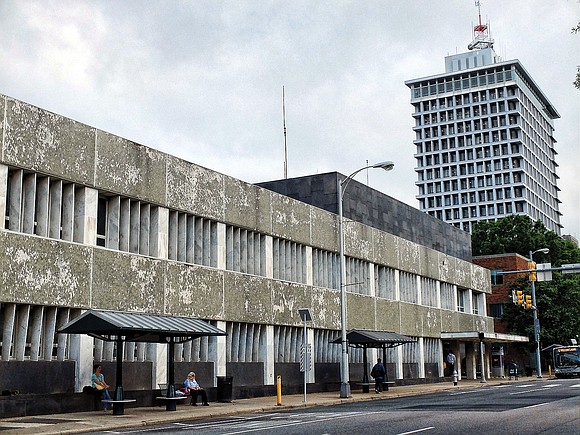City plans $3.5M sale of Public Safety Building for new development
Jeremy M. Lazarus | 2/11/2021, 6 p.m.
Unveiled nine months ago, a $325 million plan to replace the city’s decaying Public Safety Building in Downtown is gathering steam.
Mayor Levar M. Stoney on Monday sent to Richmond City Council a finished proposal to sell the building for $3.5 million to a private partnership.
The purpose: To create a complex that would include two new high-rise buildings, two nonprofit hotels along with new retail and child care space, generate new tax revenue to fund public services and create job and business opportunities for city residents.
In a bid to ensure the required seven City Council members stay on board and get the proposal passed as quickly as possible, the mayor’s team is highlighting elements of the deal that are expected to be popular.
Those include goals calling for 40 percent inclusion of Black-owned and minority-owned construction firms in building the complex, giving Richmond residents first opportunity to secure new construction jobs and ensuring city residents, particularly those needing jobs, are considered for job openings in operations that launch after the complex opens.
In addition, the deal would require the developers to formulate their project using the higher federal prevailing wage rate for Richmond and, for the first time, commit the development to ensuring that at least 40 percent of the work is done by unionized laborers and skilled tradesmen.
First offered to the city last May, the project is the brainchild of Capital City Partners, which includes visionary urban architect Michael Hallmark and developer Susan Eastridge. This is the same team that spearheaded the $1.5 billion Coliseum replacement and Navy Hill redevelopment plan that was rejected by City Council a year ago and that has proposed the $2.3 billion GreenCity arena, office and residential development in Henrico County.
Just three months after the council killed the Downtown Navy Hill project, the Hallmark-Eastridge team was back at City Hall pitching their vision for replacing the 56-year-old Public Safety Building, the one element of the Navy Hill plan most City Council members embraced.
By June, the council had given the Stoney administration the green light to begin negotiations with Capital City Partners, apparently enabling the city to avoid having to advertise for other proposals.
As outlined by Leonard Sledge, the city’s director of development, one highlight of the plan presented to the coun- cil calls for replacing the old building that opened in 1964 with two sleek 20-story office buildings, one to be occupied by VCU Health and a smaller one that would seek tenants. Those buildings would be on the Leigh Street side of the project area, which would include most of the block bounded by 9th, 10th, Clay and Leigh streets.
Closer to City Hall, the plan also calls for developing a 145-room hotel for The Doorways, a nonprofit now at 7th and Marshall streets that houses VCU Health’s patients, families and caregivers and a 60-room hotel for the Ronald McDonald House, now on Monument Avenue, which mainly serves families of patients of Children’s Hospital at VCU.
The proposal also would include 20,000-square feet of retail space, a VCU Health child care center and a 1,200-space parking deck.
Along with other items, the deal would require that up to 20 percent of the child care slots be available to city residents who do not work for VCU Health and that 200 spaces in the parking deck are available for lease to city workers.
In addition, VCU Health, The Doorways and the Ronald McDonald House Charities would partner with the city’s Office of Community Wealth Building to recruit potential employees for jobs to be filled.
Mr. Sledge called the sale beneficial to the city, allowing it to shed nearly $400,000 in yearly costs to operate and maintain the building.
To make up the difference between the sale price and the $8.5 million appraised value, he told the council that Capital City Partners would spend $1.5 million on demolition and $3.5 million on improvements, including reconnecting Clay Street between 9th and 10th streets. The only cost to the city: Relocating city operations from the building, including the drug court, a day-reporting center and an element of the city Public Works Department. The deal became possible as a result of the 2018 relocation of the police evidence and property storage space to South Side.
According to an information chart Mr. Sledge included in his presentation to City Council, the project would generate $2 mil- lion to $2.9 million annually in real estate taxes, a big difference because the city-owned building generates no tax money. He said the city should gain more in business license and other fees and taxes, but added the staff has not yet projected the amount of revenue that might come from those items.
So far, no opposition to the project has surfaced.








